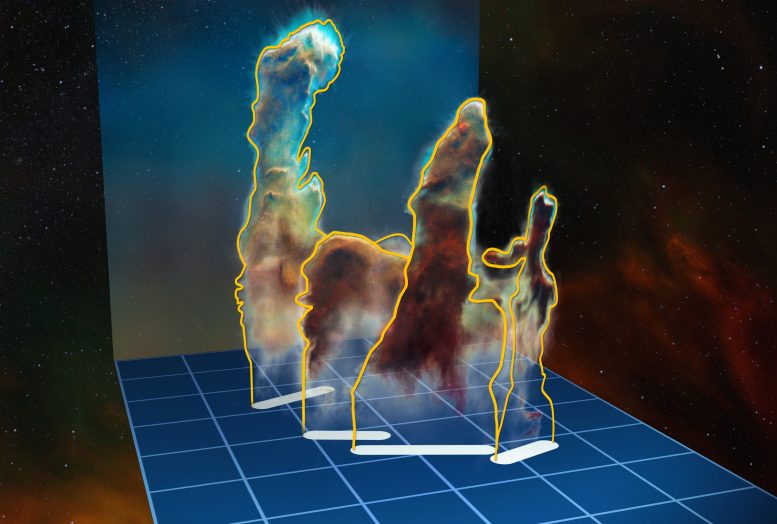
A team of astronomers reveal the first complete three-dimensional view of the famous Pillars of Creation.
Using the MUSE instrument on ESO’s Very Large Telescope (VLT), astronomers have produced the first complete three-dimensional view of the famous Pillars of Creation in the Eagle Nebula, Messier 16. The new observations demonstrate how the different dusty pillars of this iconic object are distributed in space and reveal many new details — including a previously unseen jet from a young star. The intense radiation and stellar winds from the cluster’s brilliant stars have sculpted the dusty Pillars of Creation over time and should fully evaporate them in about three million years.
The original NASA/ESA Hubble Space Telescope image of the famous Pillars of Creation was taken two decades ago and immediately became one of its most famous and evocative pictures. Since then, these billowing clouds, which extend over a few light-years [1], have awed scientists and the public alike.
The jutting structures, along with the nearby star cluster, NGC 6611, are parts of a star formation region called the Eagle Nebula, also known as Messier 16 or M16. The nebula and its associated objects are located about 7000 light-years away in the constellation of Serpens (The Serpent).
The Pillars of Creation are a classic example of the column-like shapes that develop in the giant clouds of gas and dust that are the birthplaces of new stars. The columns arise when immense, freshly formed blue–white O and B stars give off intense ultraviolet radiation and stellar winds that blow away less dense materials from their vicinity.
This video clip shows a visualization of the three-dimensional structure of the Pillars of Creation within the star formation region Messier 16 (also called the Eagle Nebula). It is based on new observations of the object using the MUSE instrument on ESO’s Very Large Telescope in Chile. The pillars actually consist of several distinct pieces on either side of the star cluster NGC 6611.
Denser pockets of gas and dust, however, can resist this erosion for longer. Behind such thicker dust pockets, material is shielded from the harsh, withering glare of O and B stars. This shielding creates dark “tails” or “elephant trunks”, which we see as the dusky body of a pillar, that points away from the brilliant stars.
ESO’s MUSE instrument on the Very Large Telescope has now helped illustrate the ongoing evaporation of the Pillars of Creation in unprecedented detail, revealing their orientation.
MUSE has shown that the tip of the left pillar is facing us, atop a pillar that is actually situated behind NGC 6611, unlike the other pillars. This tip is bearing the brunt of the radiation from NGC 6611’s stars, and as a result looks brighter to our eyes than the bottom left, middle and right pillars, whose tips are all pointed away from our view.
Astronomers hope to better understand how young O and B stars like those in NGC 6611 influence the formation of subsequent stars. Numerous studies have identified protostars forming in these clouds — they are indeed Pillars of Creation. The new study also reports fresh evidence for two gestating stars in the left and middle pillars as well as a jet from a young star that had escaped attention up to now.
For more stars to form in environments like the Pillars of Creation, it is a race against time as intense radiation from the powerful stars that are already shining continues to grind away at the pillars.
This video clip shows a visualization of the three-dimensional structure of the Pillars of Creation within the star formation region Messier 16.
By measuring the Pillars of Creation’s rate of evaporation, MUSE has given astronomers a time frame for when the pillars will be no more. They shed about 70 times the mass of the Sun every million years or so. Based on their present mass of about 200 times that of the Sun, the Pillars of Creation have an expected lifetime of perhaps three million more years — an eyeblink in cosmic time. It seems that an equally apt name for these iconic cosmic columns might be the Pillars of Destruction.
This research was presented in a paper entitled “The Pillars of Creation revisited with MUSE: gas kinematics and high-mass stellar feedback traced by optical spectroscopy” by A. F. McLeod et al., to appear in the journal Monthly Notices of the Royal Astronomical Society on 30 April 2015.
Notes
[1] The left pillar, considered as a complete object from top to bottom, is estimated to be about four light-years in length. It is the longest pillar and about twice the height of the right pillar.
Reference: “The Pillars of Creation revisited with MUSE: gas kinematics and high-mass stellar feedback traced by optical spectroscopy” by A. F. Mc Leod, J. E. Dale, A. Ginsburg, B. Ercolano, M. Gritschneder, S. Ramsay and L. Testi, 11 June 2015, MNRAS.
DOI: 10.1093/mnras/stv680
arXiv: 1504.03323
Never miss a breakthrough: Join the SciTechDaily newsletter.
1 Comment
Great. Suggestion: do it in LEGO.